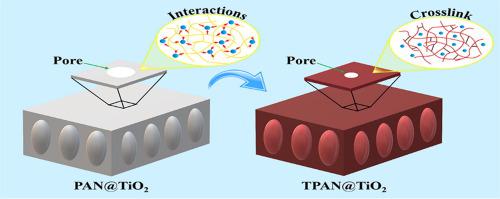当前位置:
X-MOL 学术
›
Chem. Eng. Sci.
›
论文详情
Our official English website, www.x-mol.net, welcomes your feedback! (Note: you will need to create a separate account there.)
Polyacrylonitrile (PAN)/TiO2 mixed matrix membrane synthesis by thermally induced self-crosslinking for thermal and organic-solvent resistant filtration
Chemical Engineering Science ( IF 4.7 ) Pub Date : 2020-12-01 , DOI: 10.1016/j.ces.2020.115993 Qiao Liu , Nong Xu , Long Fan , Aiqin Ding , Qiang Dong
Chemical Engineering Science ( IF 4.7 ) Pub Date : 2020-12-01 , DOI: 10.1016/j.ces.2020.115993 Qiao Liu , Nong Xu , Long Fan , Aiqin Ding , Qiang Dong

|
Abstract A polyacrylonitrile (PAN)@TiO2 mixed matrix membrane is first fabricated in-situ by the nonsolvent induced phase separation (NIPS) method. Most of the in-situ generated TiO2 nanoparticles are extracted close to the upper layer of the membrane due to their high hydrophilicity, and they strongly interact with the PAN molecules; this enables the resistance of the excessive heat-induced motion of the PAN molecules and prevents structure shrinkage of the pore structures. The thoroughly self-crosslinked PAN@TiO2 membrane (TPAN@TiO2) has a strong resistance against solvents, such as N-methylpyrrolidone (NMP), dimethylacetamide (DMAc), and dimethyl sulfoxide (DMSO). All three highly polar organic solvents exhibit 24 h stable permeance at 100 °C with the new membrane. More than 99.5% of Rose Bengal and 88.5% of rhodamine B are rejected from a solution of DMAc. Considering its superior performance, the novel membrane shows promise for application in future desalination processes.
中文翻译:

通过热诱导自交联合成聚丙烯腈 (PAN)/TiO2 混合基质膜,用于耐热和耐有机溶剂过滤
摘要 首先采用非溶剂诱导相分离(NIPS)方法原位制备聚丙烯腈(PAN)@TiO2混合基质膜。大多数原位生成的 TiO2 纳米颗粒由于其高亲水性而被提取到靠近膜上层,并且它们与 PAN 分子发生强烈的相互作用;这使得能够抵抗 PAN 分子的过度热诱导运动并防止孔结构的结构收缩。完全自交联的PAN@TiO2膜(TPAN@TiO2)对N-甲基吡咯烷酮(NMP)、二甲基乙酰胺(DMAc)和二甲基亚砜(DMSO)等溶剂具有很强的抵抗力。使用新膜,所有三种高极性有机溶剂在 100 °C 下均表现出 24 小时稳定的渗透性。超过 99.5% 的玫瑰红和 88。5% 的罗丹明 B 从 DMAc 溶液中被剔除。考虑到其卓越的性能,这种新型膜显示出在未来海水淡化过程中的应用前景。
更新日期:2020-12-01
中文翻译:

通过热诱导自交联合成聚丙烯腈 (PAN)/TiO2 混合基质膜,用于耐热和耐有机溶剂过滤
摘要 首先采用非溶剂诱导相分离(NIPS)方法原位制备聚丙烯腈(PAN)@TiO2混合基质膜。大多数原位生成的 TiO2 纳米颗粒由于其高亲水性而被提取到靠近膜上层,并且它们与 PAN 分子发生强烈的相互作用;这使得能够抵抗 PAN 分子的过度热诱导运动并防止孔结构的结构收缩。完全自交联的PAN@TiO2膜(TPAN@TiO2)对N-甲基吡咯烷酮(NMP)、二甲基乙酰胺(DMAc)和二甲基亚砜(DMSO)等溶剂具有很强的抵抗力。使用新膜,所有三种高极性有机溶剂在 100 °C 下均表现出 24 小时稳定的渗透性。超过 99.5% 的玫瑰红和 88。5% 的罗丹明 B 从 DMAc 溶液中被剔除。考虑到其卓越的性能,这种新型膜显示出在未来海水淡化过程中的应用前景。



























 京公网安备 11010802027423号
京公网安备 11010802027423号